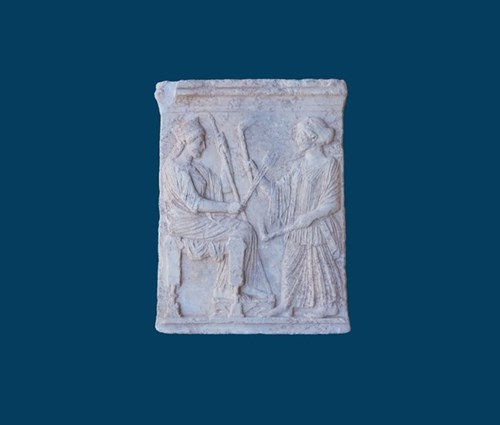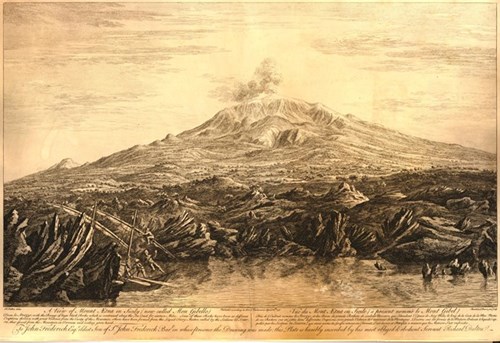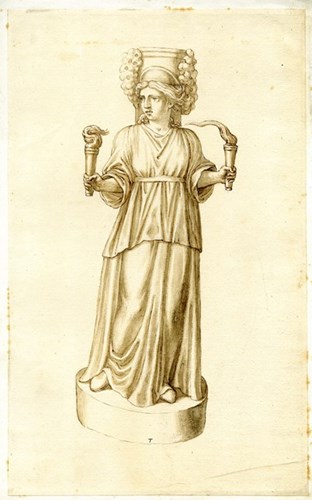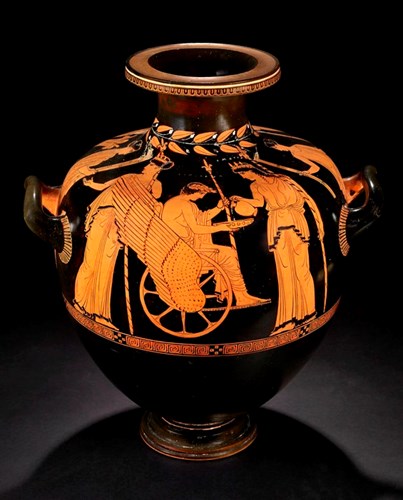The torches of Demeter
The antithesis of light and shadow defines the path of Demeter and Persephone to a great degree in the myth. The light introduces gods to the world and announces their arrival, epiphany, or departure. When Demeter enters the palace of Keleos in Eleusis, Queen Metaneira immediately recognises her as a “godlike” person, even though she cannot suspect the presence of a goddess in the figure of the despondent elderly woman standing in front of her. When Demeter revealed her true identity a few days later, a brilliance like lighting filled the rooms.

The torches are associated with purification, fertility, and the appearance of light in the darkness. They are a typical motif of Demeter in ancient sculpture and vase painting. According to the tradition preserved in the Homeric Hymn to Demeter, the goddess wandered all over the earth for nine days, holding torches ablaze in her hands in search of her lost daughter. Diodorus Siculus claims that Demeter kindled torches in the craters of Mt Etna, while Ovid reveals that the torches were made of pine. On the tenth day, the goddess came across Hecate, who approached the bereaved mother, holding a light ablaze in her hands, to assist Demeter in her desperate quest.


The torch appears next in the episode of young Demophon. Demeter attempted to render the child immortal by burying him “like a brand” in the fire to “burn off his mortality”.
The torches played a pivotal role in the Eleusinian Mysteries. The Dadouchos (torch-carrier) was among the most important officials of the sanctuary. The initiates carried torches in the procession leading from Athens to Eleusis and held them during the following pannychis, the all-night feast outside the sanctuary after their arrival. According to ancient sources, the initiates (perhaps only the women) participated in a re-enactment of Demeter’s search for her daughter with torches lit. At the same time, the ritual ended with a celebratory casting off of the torches. The joyous waving of the shining torches expressed happiness and delight for the return of the Kore.

In the iconography of Triptolemos, the torches are connected with fertility rites. The Eleusinian prince prepares to depart for his civilizing mission in the light of torches held by the goddess (Demeter, Persephone or Hecate): one torch is held upright, and the other lowered toward the ground to ensure the prosperity of the earth. The dadouch probably performed similar rituals during the celebration of the Mysteries.
Bibliography
Αλεξοπούλου-Μπαγιά, Πόλλυ. Ιστορία της Ελευσίνας: Από την Προϊστορική μέχρι τη Ρωμαϊκή περίοδο, Ελευσίνα: Δήμος Ελευσίνας, 2005.
Christopoulos, Menelaos & Karakantza, Efimia. Light and Darkness in Ancient Greek Myth and Religion, Lanham: Lexington Books, 2010.
Foley, Helene. The Homeric Hymn to Demeter: Translation, Commentary, and Interpretive Essays, Princeton: Princeton University Press, 2013.
Image source 1: Archaeological Museum of Eleusis, myEleusis.VM
Image source 2: The British Museum, image of volcano 725565001, © The Trustees of the British Museum
Image source 3: The British Museum, drawing of Hecate 2005,0928.41, © The Trustees of the British Museum
Image source 4: The British Museum, red-figured hydria 1868,0606.8, © The Trustees of the British Museum


